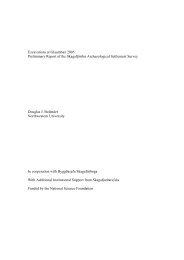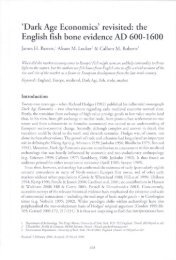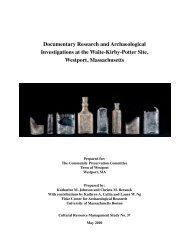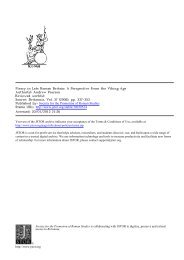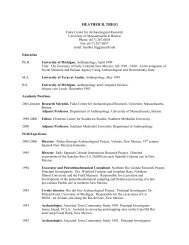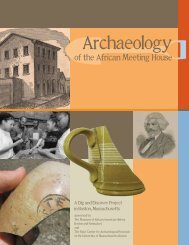archaeological site examination north yard of the ... - Fiske Center
archaeological site examination north yard of the ... - Fiske Center
archaeological site examination north yard of the ... - Fiske Center
Create successful ePaper yourself
Turn your PDF publications into a flip-book with our unique Google optimized e-Paper software.
dous change and transition. Europeanborne<br />
diseases for which <strong>the</strong> Natives had no<br />
immunity, may have killed as much as ninety<br />
percent <strong>of</strong> New England populations<br />
(Spiess and Spiess 1987; Carlson et al.<br />
1992). This tremendous loss in population<br />
had particularly negative effects on <strong>the</strong> ability<br />
<strong>of</strong> remaining community members to<br />
carry on long established traditions<br />
(Johnson 1997). This effort was made<br />
more difficult by <strong>the</strong> prejudicial European<br />
attitudes <strong>of</strong> Native peoples as uncivilized,<br />
leading to restricted use <strong>of</strong> hunting grounds,<br />
enforced Christianization (Cogley 1999)<br />
and forced removal from traditionally<br />
occupied lands.<br />
B. Native American Archaeological Sites<br />
Around <strong>the</strong> Project Area<br />
Much <strong>of</strong> <strong>the</strong> landscape in <strong>the</strong> vicinity <strong>of</strong> <strong>the</strong><br />
Loring-Greenough property has been<br />
severely impacted by urban development.<br />
Never<strong>the</strong>less, evidence <strong>of</strong> Native American<br />
occupation has been found at a number <strong>of</strong><br />
localities in <strong>the</strong> area. Isolated finds and<br />
collection <strong>site</strong>s dominate <strong>the</strong> record here.<br />
The greatest concentration <strong>of</strong> finds is from<br />
<strong>the</strong> Arnold Arboretum, due south <strong>of</strong> <strong>the</strong><br />
project area. Nine separate locations disturbed<br />
by garden cultivation have provided<br />
non-diagnostic and diagnostic projectile<br />
points including Neville-like, Archaic<br />
Notched, Small Stemmed, Orient Fishtail,<br />
Meadowwood, Atlantic, Foxcreek lanceolate,<br />
Susquehanna-like and small triangle.<br />
A small collection was made in Franklin<br />
Park to <strong>the</strong> east <strong>of</strong> <strong>the</strong> project area. To <strong>the</strong><br />
<strong>north</strong> is a historically documented fish weir<br />
on what was once Stoney Brook in Jackson<br />
Square. Finds to <strong>the</strong> <strong>north</strong>west include an<br />
isolated ground stone tool on <strong>the</strong> shore <strong>of</strong><br />
Jamaica Pond and additional material found<br />
fur<strong>the</strong>r <strong>north</strong> on <strong>the</strong> bank <strong>of</strong> Muddy River.<br />
Clear evidence <strong>of</strong> Native occupation in <strong>the</strong><br />
region, thus spans from <strong>the</strong> early Archaic<br />
through <strong>the</strong> contact period. No finds have<br />
been made in <strong>the</strong> immediate vicinity <strong>of</strong> <strong>the</strong><br />
Loring-Greenough property.<br />
C. Historic Development <strong>of</strong> Jamaica Plain<br />
Jamaica Plain was originally part <strong>of</strong> West<br />
Roxbury, founded in 1851 from its parent<br />
town <strong>of</strong> Roxbury that was established in<br />
1630. Fertile fields cleared by Native<br />
Americans for cultivation were found by<br />
<strong>the</strong> first settlers and this agricultural tradition<br />
characterized <strong>the</strong> area throughout <strong>the</strong><br />
eighteenth century. Among <strong>the</strong> early farms<br />
were <strong>the</strong> Polley Farm that included <strong>the</strong><br />
present project area and <strong>the</strong> Bussey Farm<br />
that later became <strong>the</strong> Arnold Arboretum.<br />
O<strong>the</strong>r farms were located in <strong>the</strong> valley<br />
formed by Stoney Brook. Much <strong>of</strong> early<br />
Boston’s fruit and produce was grown in<br />
this area (Pollan et. al. 1983). Close ties to<br />
Boston were maintained by <strong>the</strong> fact that <strong>the</strong><br />
two major thoroughfares that extended west<br />
<strong>of</strong> Boston, Washington and Centre streets,<br />
passed through western Roxbury. A school<br />
was established at what was to become<br />
Eliot Square in 1689 and this was followed<br />
by <strong>the</strong> establishment <strong>of</strong> a second parish in<br />
<strong>the</strong> western portion <strong>of</strong> <strong>the</strong> town.<br />
The rural character <strong>of</strong> <strong>the</strong> area encouraged<br />
<strong>the</strong> establishment <strong>of</strong> large estates by<br />
wealthy Bostonians in <strong>the</strong> mid and later<br />
eighteenth centuries. The Loring-<br />
Greenough house is <strong>the</strong> last remaining<br />
example <strong>of</strong> <strong>the</strong>se (Fig. III-1). During <strong>the</strong><br />
later eighteenth and early nineteenth centuries<br />
settlement expanded from Boston following<br />
<strong>the</strong> major thoroughfares <strong>of</strong><br />
Washington and Centre Streets. It was not<br />
until <strong>the</strong> mid nineteenth century that cross<br />
streets began to be laid out to accommodate<br />
<strong>the</strong> growing population. The Jamaica Plain<br />
Aqueduct Company was formed in 1795 to<br />
8



